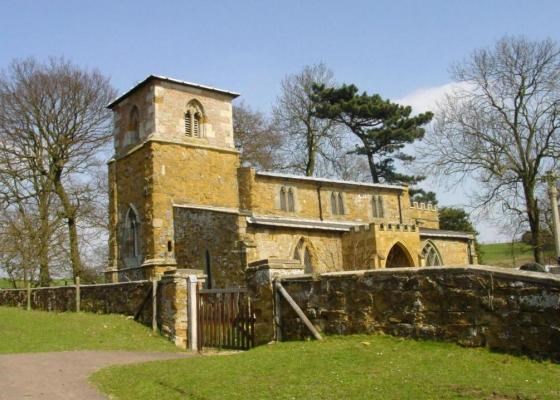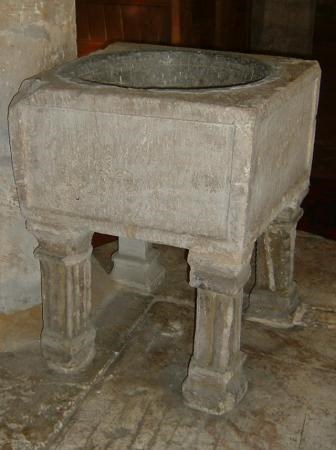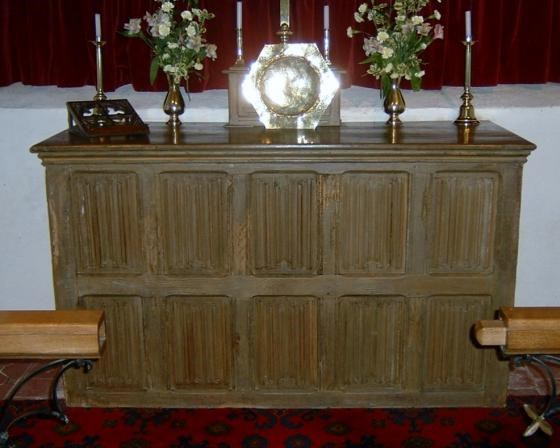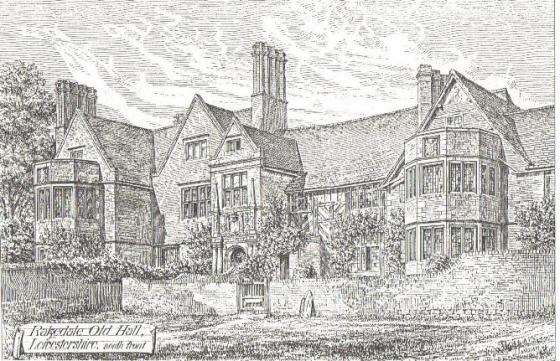Ragdale
All Saints Church, Ragdale

The Church building at Ragdale dates from the early 13th
century. Economic life was much better than it had been previously and this was
demonstrated in many cases by a more ornate style of architecture. The old
Early English style of the early 1200's was replaced by the more florid decorated
style from around 1250, which remained common until around 1350. Ragdale shows
signs of both styles: the nave is early but the south aisle, for instance, is
in the decorated style.
Hoskins book, Heritage of Leicestershire, says of Ragdale
Church: 'Here, the rough country work, too crude to date with any great
precision, has an appeal of its own. The simple arcade (stone roof supports) at
Ragdale probably belongs to the early 1300's."
Nicholas Pevsner is less than enthusiastic about the site of the
church. He describes it as being "in a miserable position" (but what did he know?). The Church is built of iron stone and there is some evidence of additions and restorations after its original building. For instance, the west tower and the south porch and
clerestory (the extra, windowed half storey) on the main body of the church)
can be dated to closer to 1400 than 1300.
The rebuilding of the chancel and porch in 1787
was commissioned by the 7th Earl Ferrers (b. 1756), who built the 'New' Ragdale
Hall in the same castellated gothic style.
There is a plaque high on the east wall of the Chancel with the
dedication to 'Robertus Comes Ferrariis, Anno Domini 1787'. He also installed
new pews. His granddaughter Caroline installed the stained glass window showing
the arms of the Ferrers and Basset families. The Bassets had been earlier
benefactors to the church — the first known rector of Ragdale was Richard
Basset, who was in office from 1220. The restoration work of 1787 unearthed a
silver coin from the reign of Henry III (1207 – 1272).

Stained glass window in the South Aisle.
The church was reopened in December 1994 after a five
year closure due to reroofing. Initially the English Heritage architect
estimated the cost of the reroofing at £35,000, of which the villagers would be
responsible for £7,000. However, when the lead was removed from the roof, the
majority of the beams were found to be completely rotten. The nave, chancel and
porch roofs were eventually rebuilt and recovered with new lead at a cost of
£125,000!
Presently the church is part of the Parish of the Upper Wreake, with the Churches in the nearby villages of Hoby, Rotherby, Frisby, Brooksby and furthest away, Kirby Bellars. However the village will be subsumed into the South West Framland Group, combining the Upper Wreake Benefice with the Borough Hill Parishes and the South Croxton Group, which will contain 20 villages with 16 churches.
The font in the church is a curiosity. It has four
different legs, said to represent the 4 gospel writers and rests on a much
older marble slab with Latin engravings – perhaps it was brought to Ragdale
from an older, deserted church. Even Pevsner poses the question "What date
might it be?" without offering an answer.

The Font
Another old curiosity is the Anglo Saxon lid of a
'Bishop's Coffin', set into the wall of the vestry, together with two curious
old grotesques. They were once situated
outside the Old Hall, but where before that?

Bishop's Coffin Lid

Grotesque

Grotesque
There are two ancient bells in the tower, the smaller
of which, dated at around 1300, is the oldest bell in the county. At the turn
of the Millennium a new bell was commissioned by Ragdale Hall Ltd. and was cast
at Taylor's Bellfoundry in Loughborough. It was hung, with the other two, for
stationary ringing.
The strikingly beautiful Altar in the chancel
is made from the old linenfold panels, rescued from the Ragdale Old Hall which
stood next to the Church and was demolished in 1958. Surviving engravings and
paintings of the Old Hall show it to be one of the finest examples of the architecture
of the late 16thC, but by the late 1950s it was in a state of some
decay and was used as a farmhouse by local tenant farmers. The crest above the
main door is preserved in a Leicester museum.

The Altar

The Old Ragdale Hall
There are many memorials to the Henton family in the
Church and in the graveyard. The most notable of these was George Moore Henton
(1861 – 1924), one of England's foremost landscape painters, whose father was
born in Ragdale in 1834. There are some Henton paintings of the Ragdale area in
the Leicester museums.
Outside, there is a cross in the churchyard which is
complete, the cross having been renewed on the original tall thin shaft, which
is said to be the longest single piece cross shaft in the country. The cross is
very ancient and suggests there may have been a place of worship on the site
even before All Saints was built. The stone stepped plinth is a later Victorian
addition.

The Ragdale Cross
When you get to the initial coordinates look for the gravestone of JOSEPH FRISBY.
He did on January A in the year BCDE, aged FG years.
The final coordinates are:
N52 46. (C – E) (F – B) (G – B) W001 01 (D x 2) (E - B) (B + E)
**************************************
****************** ********************
For full information on how you can expand the Church Micro series by sadexploration please read the Place your own Church Micro page before you contact him at churchmicro.co.uk
See also the Church Micro Statistics and Home pages for further information about the series.
****************** *******************


 Congratulatons to Plasmawave on their FTF
Congratulatons to Plasmawave on their FTF 

